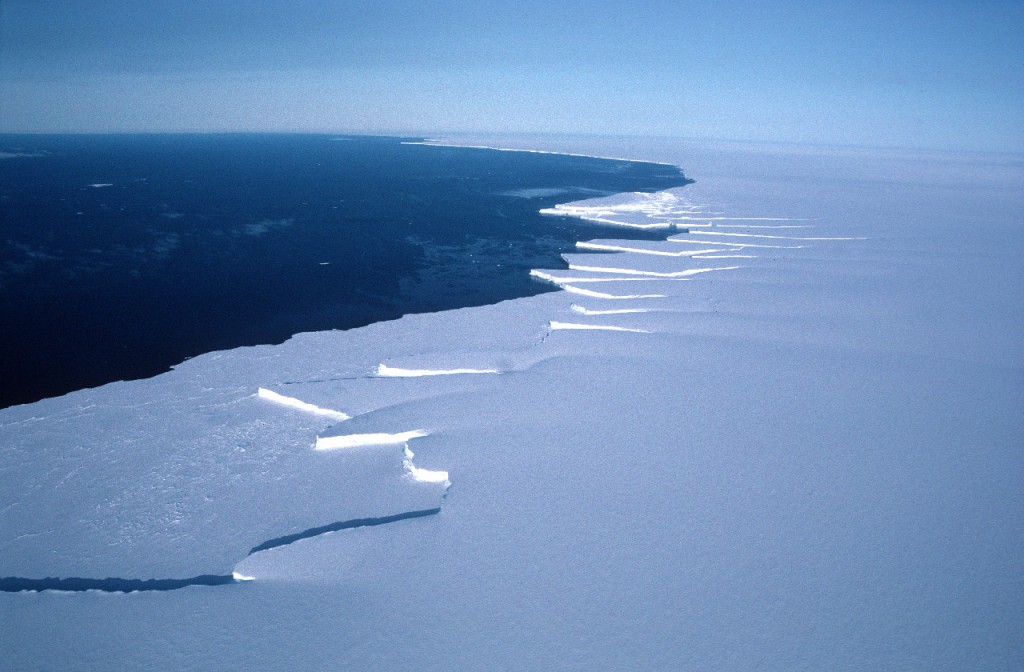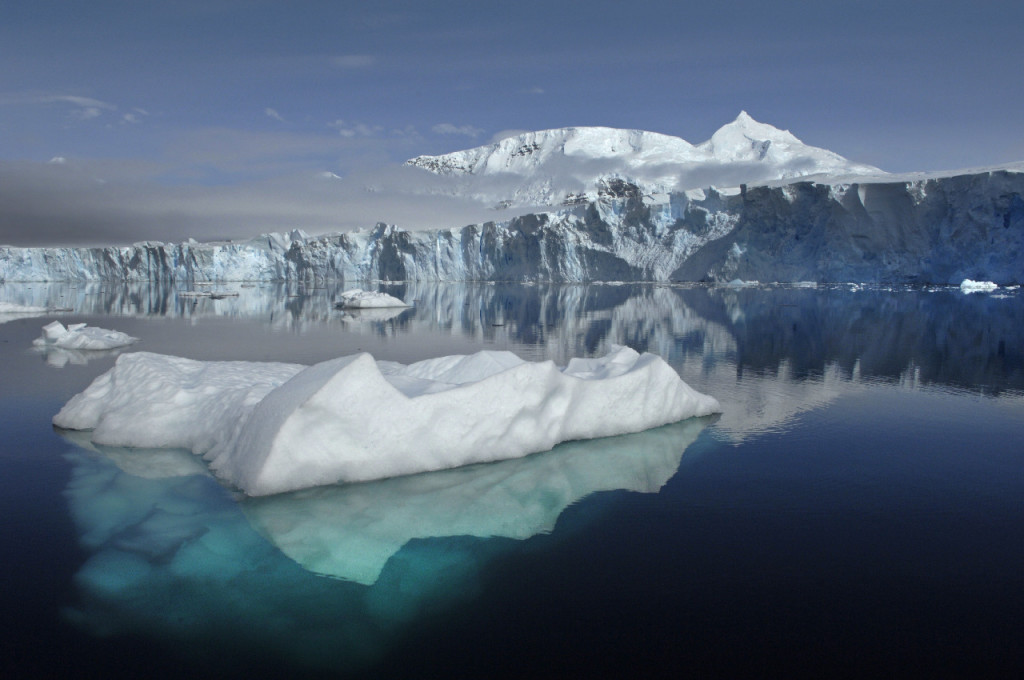Ice sheet retreat controlled by the landscape
Ice-sheet retreat can halt temporarily during long phases of climate warming, according to scientists.
A UK team led by Durham University has found that the geometry of channels beneath the ice can be a strong control on ice behaviour, temporarily hiding the signals of retreat.

The findings, which provide the first simulation of past ice-sheet retreat and collapse over a ten thousand year period in Antarctica, shed new light on what makes ice stable or unstable and will help refine predictions of future ice extent and global sea-level rise, the researchers say.
The International Panel on Climate Change (IPCC) has stated that one of the main challenges in predicting future sea-level rise is to quantify and model the interactions between evolving ice sheets, oceans, sea level and climate. Significant efforts have been made over the last decade to develop computer models and collect data in order to reduce uncertainties and understand the potential impacts under scenarios of future climate change.
The results of the new research from Durham University, the University of Sheffield, the University of Cambridge, and British Antarctic Survey are published this week in the journal Nature Geoscience.
Lead author, Dr Stewart Jamieson, a glaciologist at the Department of Geography, Durham University, said: “Our research shows that the physical shape of the channels is a more important factor in controlling ice stability than was previously realised. Channel width can have a major effect on ice flow, and determines how fast retreat, and therefore sea-level rise, can happen.”
Although climatic and oceanic changes are crucial drivers of ice loss, the research shows that the landscape below the ice strongly controls the speed of any retreat.
Dr Jamieson added: “Our results suggest that during an overall phase of retreat an ice stream can appear almost stable when in fact, in the longer-term, the opposite may be the case.
“Getting a clearer picture of the landscape beneath the ice is crucial if future predictions of change in the ice-sheets and sea level are to be improved.”

Marine-based ice streams are the fast flowing arteries of ice sheets, draining approximately 90 per cent of the ice that reaches the sea. They flow through large channels where the ice can move thousands of metres in a year. According to the scientists, the unpredictable nature of ice streams makes forecasting ice-sheet retreat extremely difficult. If ice streams speed up they can cause sea level to rise.
Durham University co-author Dr Chris Stokes said: “Ice streams are like taps filling a bath, but the problem here is that we do not know if something is suddenly going to turn them up or even turn them off.”
Satellite imagery from the last 20 years has led to advances in our knowledge of ice sheet stability and has shown that many ice streams are getting thinner and retreating because the ocean and climate are warming. The new research shows that ice behaviour can successfully be simulated in places where ice streams meet the sea.
The researchers looked at the landscape of the seafloor in Marguerite Bay, in the Antarctic Peninsula, and saw that during a rapid phase of recession 13,000 years ago, retreat paused many times. Using a computer model designed to work in situations of rapid change, they found they could reproduce the same pattern in a series of simulations. These showed that ice dragged on the sides of the channel more where it was narrow, causing retreat to slow and in places temporarily stop for decades to centuries before retreat continued.
Many ice streams are found in channels with beds that are below sea level and that deepen inland. Current theory suggests that ice loss can increase rapidly in deeper water, but the new findings show that channel width plays a crucial role and that narrow bottlenecks in the landscape beneath the ice can cause retreat to slow down.
Dr Andreas Vieli, Department of Geography, Durham University, said: “We can see from our simulations and from new maps of the ocean floor that these bottlenecks occur in the same place as pauses or slowdowns in past ice retreat. This means we should look more closely at the shape of the bed underneath Greenland and Antarctica to better understand how ice might retreat in the future.”
Dr Claus-Dieter Hillenbrand from British Antarctic Survey added: “Knowledge of the factors influencing stability and retreat of ice streams is of particular concern because significant portions of the West Antarctic and Greenland ice sheets are currently losing mass that contributes significantly to sea-level rise. Our model results help to explain the apparently time-transgressive retreat of ice streams around Antarctica following the last ice age.”
The researchers say that understanding ice-stream behaviour and the rate of mass loss from ice sheets and glaciers is essential.
The research was financially supported by the Natural Environment Research Council, UK.
ENDS
Press Office Contacts
Issued by Durham University Media Relations Office; Telephone: +44 (0)191 334 6077
Interviews
Dr Stewart Jamieson, NERC Postdoctoral Fellow in the Department of Geography, Durham University, is available for interviews at various times on Friday and Monday and Tuesday October. Tel: +44 (0) 191 33 41931. Email: stewart.jamieson@durham.ac.uk
Durham University Media Relations contact:
Tel: +44 (0)191 334 6075; Email: c.r.stiansen@durham.ac.uk or media.relations@durham.ac.uk
British Antarctic Survey media contact:
Audrey Stevens, Tel: +44 (0) 1223 221414; Email: auev@bas.ac.uk
Natural Environment Research Council media contact:
Marion O’Sullivan, Tel: +44 (0) 1793 411727; Email: pressoffice@nerc.ac.uk
Note for broadcasters
Durham University has an ISDN line on site. Please contact the Media Office on +44 (0)191 334 6077 to arrange interviews.
The ISDN number is +44 (0)191 386 2749. Durham University is 30 minutes from BBC and independent TV/radio studios.
Images
Images of ice sheets and ice streams are available. For copies please contact: Durham University Media Relations: E: media.relations@durham.ac.uk T: +44 (0)191 334 6075
Web links:
Department of Geography at Durham University: http://www.dur.ac.uk/geography/
Quaternary Environmental Change research group: http://www.dur.ac.uk/geography/qec/
Copies of the research paper: “Ice-stream stability on a reverse bed slope” are available. Journal: Nature Geoscience.
Glossary:
- Glacier
- a ‘river of ice’ fed by the accumulation of snow. Glaciers drain ice from mountains to lower levels, where the ice either melts, breaks away into the sea as icebergs, or feeds into an ice shelf.
- Ice sheet
- the huge mass of ice, up to 4 km thick that covers bedrock in Antarctica or Greenland. It flows from the centre of the continent towards the coast where it feeds ice shelves.
- Ice shelf
- the floating extension of the grounded ice sheet. Composed of freshwater ice that originally fell as snow, either in situ or in land and brought to the ice shelf by glaciers. As they are already floating, any disintegration will have no direct impact on sea level. Sea level will rise only if the ice held back by the ice shelf flows more quickly onto the sea.
Durham University is a world top-100 university with a global reputation and performance in research and education. The most recent UK league tables place Durham in the top echelon of British universities academically. Durham is ranked in the top 3 UK universities in the influential Sunday Times University Guide 2012; is 26th in the world for the impact of its research (THE citations ratings) and 15th in the world for the employability of its students by blue-chip companies world wide. We are a residential Collegiate University: England’s third oldest university and at our heart is a medieval UNESCO World Heritage Site, of which we are joint custodians with Durham Cathedral. Durham is a member of the Russell Group of leading research-intensive UK universities.
The Natural Environment Research Council (NERC) is the UK’s main agency for funding and managing world-class research, training and knowledge exchange in the environmental sciences. It coordinates some of the world’s most exciting research projects, tackling major issues such as climate change, environmental influences on human health, the genetic make-up of life on earth, and much more. NERC receives around £320 million a year from the government’s science budget, which it uses to fund independent research and training in universities and its own research centres.
